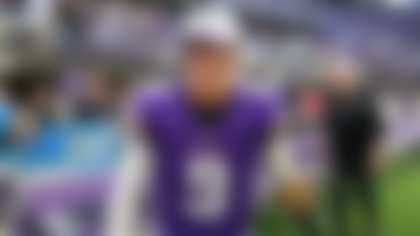After a Wild Card Weekend that produced three road winners in four games, we're poised for a Divisional Round overflowing with intriguing matchups: Patrick Mahomes vs. Andrew Luck; Aaron Donald vs. Dallas' offensive line; Tom Brady vs. Philip Rivers; and, for good measure, the best home dome team vs. the best underdog story.
There are so many juicy characters and narratives that it's hard to hone in on what really matters. But here's the best part about creating models like mine: They have no bias. My model's "storylines" aren't influenced by anything other than how team attributes and performances line up against a large blend of historical, contextualized, situational data and coach-vetted strategic inputs.
During the regular season, in games where my model returned 60 percent or higher confidence in the output, the accuracy in picking game winners was 74.7 percent (113-38-1). You see, the way the model chooses these winners is by identifying the most important factors in determining each game's outcome. All of those factors also get a confidence rating. Then, after the game, the actual results (including the key factors that decided the outcome) are compared to the projected ones and the model gets "graded." Factors with confidence ratings of 60-plus percent drive the final score accuracy (and also help contextualize rare events, like a blocked field goal). This is how the accuracy of the model improves each week -- and how my model projects which analytics-based storylines will be the most impactful in future games.
In preparing this piece, I ran 20,000 simulations for every one of the seven remaining playoff games (140,000 total). Below, you'll find the following for each of the eight teams still trying to hoist the Lombardi Trophy: conference title probability, Super Bowl title probability and one high-confidence factor that the model flags as its analytics-based storyline. Use these objective components, combined with all the awesome subjective analysis available this week, to make your case for (or against) each team.
Here is my key factor for the eight remaining teams, presented in alphabetical order:
Dallas Cowboys
Win NFC: 14.3 percent.
Win Super Bowl: 7.1 percent.
Analytics-based storyline: Explosive-play prevention.
The Cowboys' defense allowed the second-fewest big plays during the regular season (82). Big plays comprise of rushes of 10-plus yards and passes of 20-plus yards. How did Dallas do such an effective job in this area? Well, the emergence of Leighton Vander Esch and Jaylon Smith definitely helped, as both young linebackers are highly effective against the run and pass. Meanwhile, the Cowboys allowed the fourth-lowest completion percentage (54.3) when their defensive backs were within 3 feet of opposing pass catchers. This sounds a little funny, but it approximates man-to-man coverage for computer vision. So, between exceptional linebacker play (in terms of both run-stopping and pass coverage) and highly efficient man-to-man work in the back end, the Cowboys minimize big-yardage gains. And that's what makes Saturday night's matchup so enticing, as the Rams led the NFL with 133 big plays during the regular season. Explosive plays off of play-action define the Rams' offense when it's operating at its best. Who will win the battle of big plays? Well, that might just be the game's deciding factor.
Indianapolis Colts
Win AFC: 14.1 percent.
Win Super Bowl: 7.7 percent.
Analytics-based storyline:Eric Ebron in the red zone.
Of the Colts' 52 total offensive touchdowns during the regular season, 44 occurred in the red area. And of Ebron's 13 touchdown receptions (most among tight ends), 10 were red-zone scores (also most among TEs). This crazy production, along with Ebron's ability to draw coverage even when he wasn't targeted inside the opponent's 20, helped drive the Colts' 54.1 percent third-down conversion rate in this area of the field (second-best in the NFL). The Chiefs' defense had the regular season's second-worst red-zone touchdown percentage (72.4 percent) and tied for 28th in touchdowns allowed (49), primarily due to losing matchups in the middle of the field in the red area. The Chiefs will have to find a solution for Ebron in order to slow the pace of the Colts' offense.
Kansas City Chiefs
Win AFC: 37.5 percent.
Win Super Bowl: 17.5 percent.
Analytics-based storyline:Chris Jones' internal pressure.
Only one interior pass rusher has more disruptive pressures than Chris Jones (spoiler alert, it's Aaron Donald). Jones' traditional stat line of 15.5 sacks, 29 QB hits and 46 pressures (with Next Gen Stats providing the latter two stats) is already incredibly impressive. Then you add the context that 11.5 of his sacks came in his last eight games, when offensive contact (which is how I approximate double teams, chipping, etc. with computer vision) went up in each game. I wrote about the Chiefs' pass rush as a strength last week, but I'm spotlighting Jones because I haven't heard enough positive praise thrown his way. And the Colts' O-line vs. K.C's D-line will be a huge factor on Saturday. Indy yielded a league-low 18 sacks during the regular season, and it didn't allow a single one to the Texans' ferocious front (headlined by J.J. Watt and Jadeveon Clowney) on Wild Card Weekend. I can't wait to see the plays where Jones lines up against rookie All-Pro guard Quenton Nelson.
Los Angeles Chargers
Win AFC: 18.3 percent.
Win Super Bowl: 9.4 percent.
Analytics-based storyline: Running back efficiency.
In their 12 wins during the regular season, the Chargers average 4.84 yards per rush on first and second downs. They were balanced on early-down play calling (51.8 rush), which kept opposing defenses guessing and helped fuel a robust average of 6.3 yards per offensive play (third in the NFL). In order to avoid the Pats' pass rush and keep their own guards out of heavy-pressure situations (they have allowed a bottom-10 disruptive-pressure figure among guard units: 23.6 percent of pass plays), the Bolts' ability to leverage positive ground gains on early downs is a key. New England's defense allowed a league-high 7.2 yards per rush on first down over the last five games of the regular season. Melvin Gordon and Austin Ekeler were both banged up in the second half of the regular season, but their contributions will be key on Sunday.
Los Angeles Rams
Win NFC: 34.0 percent.
Win Super Bowl: 17.2 percent.
Analytics-based storyline: O-line efficiency.
If you haven't realized it yet, O-lines are REALLY big factors in game outcomes, playing far more substantial roles than subjective narratives usually convey. While the Rams' offensive line allowed a 17.7 percent disruptive-pressure rate in their first 12 games of the season, that figure has jumped to 29.2 percent over the past four. In the Rams' Week 15 loss to the Eagles, Michael Bennett's ability to pressure from the defensive left really threw a wrench into L.A.'s offense. So, one key matchup to watch is Rams RT Rob Havenstein vs. Cowboys DE DeMarcus Lawrence. Lawrence just hit double-digit sacks in his second straight regular season -- can Havenstein keep him at bay? Since the Rams' run defense has been inefficient (SEE: my article from last week), pressure on Jared Goff becomes an even bigger factor in this game. If Dallas can successfully pressure Goff, that'll bring L.A.'s offense to a halt, limiting first downs (and, inherently, touchdowns). Meanwhile, the Cowboys can control the clock by grinding through the Rams' lackluster run defense with Ezekiel Elliott, thus eliminating a possession or two. This would change the Rams' urgency, spawning more obvious passing plays -- and more opportunities for Lawrence and Co. to pressure Goff. Los Angeles' offensive line has to stand tall Saturday night in the Coliseum.
New England Patriots
Win AFC: 30.1 percent.
Win Super Bowl: 16.5 percent.
Analytics-based storyline: Pounding the rock with heavy personnel.
New England utilized two-RB personnel groupings quite frequently during the regular season. The Pats deployed 21 (2 RB, 1 TE, 2 WR) and 22 (2 RB, 2 TE, 1 WR) personnel the second- and fourth-most often, respectively. I bring this up because we've seen the Chargers' defense field seven defensive backs the most in the league. According to Next Gen Stats, Gus Bradley's D accounted for 50 of the 353 league-wide snaps with seven DBs during the regular season. Then, in last week's win at Baltimore, the Bolts had seven DBs on the field for a whopping 58 of 59 snaps -- and it worked quite effectively, as L.A. yielded just 3.9 yards per play. One way to counteract this "small ball" defense is to use heavier personnel packages. The Patriots have consistently found success on early downs by leveraging their physical backs. New England owns the league's second-highest figure when it comes to first downs gained on first/second down (averaging 15.6 per game). If backs like Sony Michel are able to earn extra yards off of smaller-sized defensive backs playing at the linebacker position, the Pats will be able to control the pace of the game, limit the impact of the Chargers' excellent pass rushers and keep Tom Brady on the field. One note: If you see Michel and James Develin on the field at the same time, it's likely to be a rushing attempt, as this has been the case on 82.7 percent of their plays on the field together.
New Orleans Saints
Win NFC: 38.6 percent.
Win Super Bowl: 18.2 percent.
Analytics-based storyline: Offensive efficiency.
New Orleans' offense operates most efficiently when a foundation of quick, strategic passes/rushes sets up tactical, matchup-based explosive plays downfield. In order to get off a high volume of quick passes, the Saints need to mitigate immediate pressure coming up the gut. This makes the health of their O-line, especially on the interior, critical -- particularly when going against Philadelphia's stout D-line. Over the Eagles' past four games, the defensive front's ability to generate disruptive pressure has almost doubled (from 16.5 percent of passing plays in their first 13 games to 28.4 percent in the past four). Disruptive pressures are those that influence the outcome of drives by limiting earned first downs and touchdowns, and Philly's improved third-down conversion rate has reflected this, with opponent success at 22.6 percent in the Eagles' past four games, as opposed to 37.6 percent in their first 13. Meanwhile, the Saints' O-line has been banged up in recent weeks, though the unit did just get a week off for rest and recuperation. When all five starters have been playing, no group has allowed fewer disruptive pressures on passes (just 13 percent of all pass plays). Two individual matchups that could go a long way toward deciding the winner of this trench battle -- and thus, this game -- are Larry Warford lined up against Fletcher Cox (offensive right/defensive left) and Ryan Ramczyk vs. Michael Bennett (also on the offensive right).
Philadelphia Eagles
Win NFC: 13.1 percent.
Win Super Bowl: 6.5 percent.
Analytics-based storyline:Nick Foles' quick release.
According to Next Gen Stats, 48.9 percent of Nick Foles' passing attempts have come under 2.5 seconds (115 of 235). And on those attempts, St. Nick's been at his best: 78.3 completion percentage, seven touchdowns, one interception and a 110.9 passer rating. (He's posted two TDs and five INTs when he throws after 2.5 seconds.) The Saints logged the seventh-most defensive pressures (175) during the regular season, but they came in at 11th in disruptive-pressure rate (17.3 percent). This is partially because of the time it took New Orleans between snap and pressure (contact) was about 0.4 seconds slower than the league average, which helps explain why the Saints allowed a 63.3 percent red-zone touchdown rate (ranking 23rd). Perimeter rushing does take longer, so quick passes become a problem.
Follow Cynthia Frelund on Twitter @cfrelund.












